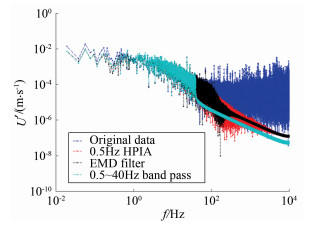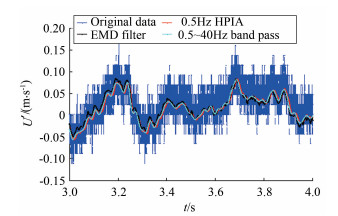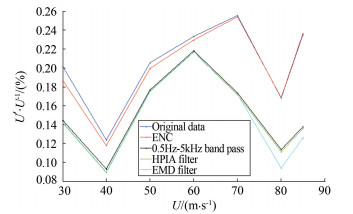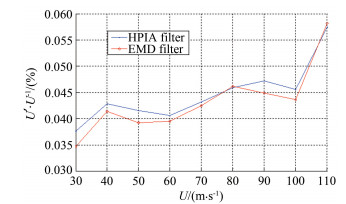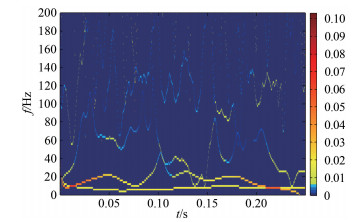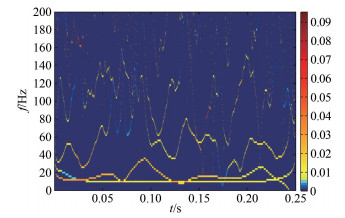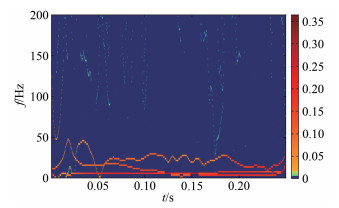Digital signal process of low turbulence intensity based on EMD
-
摘要: 采用热线风速仪在3座典型低速风洞中进行了流场湍流度测量,这3座低速风洞包括1个低湍流风洞、1个常规闭口风洞和1个开口射流风洞。针对湍流信号通常受噪声干扰的问题,在湍流度值处理中引入了经验模式分解(EMD)自适应滤波和HHT时频谱分析方法。将EMD方法与其他几种湍流度值处理方法进行了比较,包括带通滤波方法(BP)、电磁噪声解耦方法(ENC)和高通惯性衰滤波方法(HPIA)。采用EMD方法测得低湍流风洞的湍流度值,在流场速度30~100 m/s的范围内小于0.05%。采用HHT方法完成了脉动速度信号的时频分析,分析发现开口风洞试验段的脉动速度HHT时频谱有突出的低频信号。所构建的EMD自适应滤波器可以有效控制噪声对热线输出信号的影响,是一种有效的低湍流度信号处理方法。Abstract: Hot wire anemometer is used in three typical low speed wind tunnels to measure the flow field turbulence intensity, including a low turbulence wind tunnel, a general closed wind tunnel and an open jet wind tunnel. To deal with the disturbance to the turbulence signal caused by noise, an EMD(Empirical Mode Decomposition) self-adaptive filter and HHT(Hilbert-Huang Transform) time-frequency analysis methodology are introduced in turbulence intensity data processing. The EMD method is compared with several other turbulence intensity processing methods, including BPF(Band Pass Filter), ENC(Electronic Noise Correction) and HPIA(High Pass Inertia Attenuation Filter). Using the EMD filter, the turbulence intensity in the low turbulence wind tunnel test section is measured and found to be less than 0.05% in the flow speed range of 30~100m/s. Using HHT method, we complete the time-frequency analysis of the flow fluctuation signal, and the low frequency flow flucturation signal is found predominatnt in the open jet wind tunnel. The designed EMD self-adaptive filter is effective at controlling the influence of the noise on the hot wire output signal, and therefore it is a practical method for low turbulence intensity signal processing.
-
0 引言
由于湍流度对飞行器绕流的流动结构有较大影响,可直接影响翼型等气动部件的边界层转捩位置及分离位置,从而改变飞行器的升阻比和俯仰力矩特性[1-2],因此,湍流度是风洞流场校测的重要指标,需要在飞行器模型的风洞试验中对风洞湍流度进行准确测量,并对其影响进行修正以提高风洞试验数据精准度。目前,测量流场湍流度的最理想仪器是热线风速仪(简称热线),但是由于测量目标为动态信号,导致测量结果容易受到干扰,特别对于低湍流度测量而言,更容易受到电磁干扰[3-4]和支架干扰[5]。因此,在低速风洞低湍流度测量中,需要对数据进行有效的信号处理[6-11]。
自20世纪30年代末至今,为推动湍流机理、边界层转捩和翼型层流化研究的不断发展,国内外已建造约30座低湍流度风洞[4]并开展了大量研究工作,研究提出多种信号处理方法,降低干扰噪声的影响从而提高了低湍流测量的准确性。文献[6]采用0.1Hz~1kHz带通滤波BP(Band Pass)方法,测得试验段湍流度0.069%(5m/s)、0.086%(15m/s);文献[7]采用10Hz~1kHz的BP方法,测得开口试验段喷口位置X/D=0.042的核心流湍流度0.02%(33ft/s);文献[8]采用1Hz~10kHz的BP方法,测得试验段湍流度0.05%(动压200m/s);文献[9]采用1H z~4kHz的BP方法测得试验段湍流度0.05%(150 ft/s);文献[10]采用电磁噪声解耦ENC(Electronic Noise Correction)方法,测得试验段湍流度0.025%(Ma0.05)、0.3%(Ma0.2);文献[11]采用声波干扰去相关方法,测得试验段湍流度0.02%(18~53m/s);文献[12]提出了用尺度间变化的门限值来抑制带噪湍流信号在不同尺度上的噪声子波系数, 从而实现了在重构湍流信号中消除噪声;文献[3]采用快速收敛迭代法对测量数据进行信号处理并考察处理前后统计湍流量的变化,发现噪声的存在不仅对湍流小尺度统计量的估算影响显著,也对与大尺度关联的量产生一定的影响;文献[13]采用高通惯性衰减滤波方法HPIA(High Pass Inertia Attenuation Filter)测得试验段湍流度0.05%(30~100m/s)。
经验模式分解EMD(Empirical Mode Decomposition)方法是美国学者Huang等在1998年提出的一种信号处理技术[14], 成功应用于海洋、地震、机械振动分析、声音处理、纹理分析、影像滤波以及气象等领域的数据分析中[15]。通过EMD分解得到的基本分量称为本征模函数(Intrinsic Mode Function, IMF)分量,对所有的IMF分量进行HHT(Hilbert-Huang Transform)变换, 可以得到整个信号的HHT时频谱。通过HHT时频谱不但能够知道信号具有哪些频率成分以及对应成分的大小,更关键的是还能够知道各个频率成分出现的时刻,从而将时域和频域特征很好地联系起来。
本文根据低速风洞低湍流度信号的特征,通过实验构建了一种基于EMD的自适应滤波器进行信号处理,采用同一阈值处理3种低速风洞的湍流度数据,避免了由于不同低速风洞的干扰频率差异,导致的滤波参数不统一的问题,便于比较不同低速风洞的湍流度值;对热线信号进行了HHT时频谱分析,分析发现开口风洞试验段存在明显的低频速度脉动信号。
1 风洞设备及热线仪
1.1 风洞设备
本文主要试验在低湍流风洞、常规闭口风洞和开口射流风洞等3种典型低速风洞上进行。低湍流风洞稳定段设置6层阻尼网,流场湍流度设计指标为0.05%。开口风洞流场湍流度设计指标为0.2%。常规低速风洞稳定段设置3层阻尼网,流场湍流度设计指标为0.5%。
1.2 热线仪
热线仪采用丹麦丹迪公司的Streamline系统,测量探头主要有55P11一维探头和55P61二维探头,测点布置于风洞试验段的中心,系统配置的采集卡分辨率为16位。数据采样频率为20kHz,采样时间为30s。
2 低湍流度信号的EMD处理和自适应滤波
根据EMD方法[14-17]对采样信号x(t)进行分解,可表示为:

(1) 式中:ci(t)表示分解的第i个本征模函数分量,r(t)表示残余信号分量。
对ci(t)进行HHT变换可以表示为:

(2) 构造解析函数:

(3) 式中:瞬时幅值为

(4) 瞬时相位为

(5) 瞬时频率为

(6) 瞬时幅值Ai(t)和瞬时频率fi(t)同时为时间t的函数,( Ai(t), fi(t), t)构成了HHT时频谱。
由于EMD方法是按照高频到低频分解信号,因此,只要对低频分解信号进行重构,就可以去掉低湍流度信号中的高频干扰:

(7) 又由于高斯白噪声信号的IMF分量的能量密度与其平均周期的乘积为一常量[16],即

(8) 因此,可以通过查验相邻IMF的const值变化情况来判定分解信号是否受到了白噪声干扰,从而确定分解信号重构的IMF分量的级数m,m值可以是EMD从高频到低频分解过程中满足下式的第一个解(试验中发现,热线信号容易受低频白噪声影响,可导致低频部分存在第2个解,若将第2个解也作为判定级数,从而滤除低频干扰信号,可以进一步构建一个自适应的带通滤波器):

(9) 能量密度为

(10) 平均周期为

(11) 上述通过判定级数m值从而进行IMF分量的重构过程,可以理解为一种自适应滤波方法。其中,N为分解信号的数据总量,Pm为第m个分解信号的极值点总数,C值为常数,C直接影响到滤波的质量。表 1是本文3种低速风洞中的能量密度与其平均周期的乘积变化情况,可见,Rm值在2~3的范围内是一个突变区域,Rm值在这个范围内迅速增大。采用文献[13]对热线高频干扰信号的自谱分析方法,认为Rm值的突变是干扰引起的,即Rm值大于2~3以上的信号受到了电磁干扰和支架干扰的影响,因此,对C取值为2作为EMD滤波器的阈值,采用这一阈值滤波后的信号频谱如图 1所示,在图中,有效信号得到最大限度保留,高频干扰信号被抑制。
表 1 3种低速风洞中的能量密度与其平均周期的乘积Table 1 A list of Em×Tm in the 3 kinds of low speed wind tunnel风洞类型 R1 R2 R3 R4 R5 R6 R7 R8 R9 R10 R11 R12 R13 R14 R15 R16 低湍流 0.44 0.05 0.10 0.04 0.22 0.21 0.03 0.01 1.05 33.79 37.20 47.05 27.88 27.62 7.76 3.96 常规低速 0.34 0.21 0.03 0.17 0.07 0.01 0.53 0.20 0.50 1.99 16.60 25.63 36.38 11.32 20.11 4.31 开口风洞 0.65 0.25 0.03 0.01 0.02 0.11 0.03 0.20 0.09 0.79 9.01 8.68 451.32 18.75 13.57 19.57 3 湍流度测量结果和分析
3.1 几种滤波方法获得的脉动速度频谱比较
从脉动速度的频谱图可以直观地比较不同方法对湍流度值的处理效果[13]。图 1是低湍流风洞试验段风速为90m/s时的脉动速度幅值谱,采用EMD自适应滤波、高通惯性滤波和频域BP方法[18]等3种方法进行了信号处理。图 2是图 1采用3种方法获得的脉动速度的时域数据。由于低频干扰在风洞测试数据中普遍存在,低频脉动速度对转捩影响未知[8],一般数据处理都对低频干扰进行了高通滤波,高通滤波参数在0.1~10Hz之间[6-9],因此,本文考虑热线在较长时间工作中的加热氧化和温度漂移等低频干扰影响,在上述3种方法中也同时采用了0.5Hz高通滤波。
从图 1可见,3种信号处理方法在0.5~40Hz之间的处理结果接近,由于40Hz以下的幅值比40Hz以上的幅值大1至2个数量级,因此,这3种信号处理方法获得的结果也基本接近(见图 2),但是,高频部分的处理对测量结果略有影响,EMD自适应滤波结果比0.5~40Hz的BP结果更接近于高通惯性滤波结果。
3.2 几种方法测得的湍流度结果比较
图 3为采用4种处理方法对开口风洞试验段数据进行处理获得的湍流度结果比较。由图可见,因为开口试验段低频压力脉动较大,0.5Hz高通滤波对试验数据的影响较大,高频干扰信号对测量结果的影响相对较小,因此ENC方法[10]测得的湍流度结果与原始值接近,0.5Hz~5kHz的BP、0.5Hz的HPIA和EMD自适应滤波结果接近。BP、HPIA和EMD方法测得的开口风洞试验段湍流度值在除60m/s外的大部分风速段都满足设计指标0.2%。从本文的使用情况看,BP方法最简洁,但不具备自适应性,而且截止频率以外的有效信号有可能被抑制。ENC方法经过初始电磁环境标定后,原则上可用于类似的电磁环境,但仅对电磁干扰的抑制有作用,无法抑制支架干扰信号。HPIA可较大限度地保留原始信号的高频特征,但不属于自适应滤波方法。EMD方法采用统一阈值滤波,对不同环境中的干扰信号抑制效果较好,具有自适应性。
图 4和5分别是低湍流风洞试验段和常规低速风洞的湍流度信号处理结果。从图中可见,采用EMD和HPIA方法测得的结果比较接近,EMD比HPIA的处理结果略小。低湍流风洞试验段湍流度值在流场速度100m/s以下优于设计指标0.05%,常规低速风洞试验段湍流度值在所测试风速范围内优于设计指标0.5%。
3.3 脉动速度信号的HHT时频分析
图 6是对图 1中原始数据的所有IMF分量进行变换获得的0~200Hz信号的低湍流风洞试验段90m/s风速HHT时频谱。从图中可见,在100Hz以下,气流脉动速度的频率和幅值随时间呈现一定的连续变化。在100~200Hz之间,这种连续变化逐渐变成离散状态。EMD自适应滤波器在100~200Hz之间根据高斯白噪声的特点,确定了分解重构的IMF级数m并进行滤波。从图 1的FFT幅值谱也可见,EMD滤波获得的信号幅值在100Hz以后逐渐衰减。
图 7是常规低速风洞90m/s风速时的0~200Hz脉动速度HHT时频谱,图 8是开口风洞试验段90m/s风速的0~200Hz脉动速度HHT时频谱。由图可见,常规低速风洞脉动速度的幅值和频率变化在50~200Hz范围内,比低湍流风洞试验段略丰富些。开口风洞试验段脉动速度幅值较大,而且主要是50Hz以下的低频信号,这种信号一般是开口射流中的大涡结构引起的低频压力脉动和动压波动,在时频图中显示的幅值较为突出,是开口风洞调试和优化的重要指标。
图 9是图 7的200~1000Hz高频部分,图 10是图 8的200~1000Hz高频部分。在高频部分可见,2座风洞的速度脉动幅值和频率特征都比较接近,频率越高,信号被白噪声干扰越严重,信号幅值变化不连续,呈现为离散特征。
4 结论
本文给出了一种基于EMD的低湍流度信号处理分析方法, 采用这种方法对3种低速风洞流场进行了测试,并与ENC、HPIA和BP等方法进行了比较。
(1) EMD自适应滤波方法可根据信号中的白噪声参数确定分解重构信号的级数,其低湍流度信号处理结果略低于ENC、HPIA和BP等方法测得的结果。
(2) 采用同一EMD自适应滤波器分别测得3种低速风洞的流场湍流度,测量结果表明该方法适应性较好。低湍流风洞试验段流场的湍流度值在流场速度为30~100m/s时优于设计指标0.05%,开口风洞试验段的湍流度值在除60m/s外的大部分风速段都满足设计指标0.2%,常规低速风洞各风速段流场湍流度低于0.2%。
(3) 采用EMD方法获得的HHT时频谱可以分析脉动速度信号的时频特征。分析发现开口风洞试验段的HHT时频谱有明显较大的低频脉动信号,可以为风洞调试提供分析依据。
-
表 1 3种低速风洞中的能量密度与其平均周期的乘积
Table 1 A list of Em×Tm in the 3 kinds of low speed wind tunnel
风洞类型 R1 R2 R3 R4 R5 R6 R7 R8 R9 R10 R11 R12 R13 R14 R15 R16 低湍流 0.44 0.05 0.10 0.04 0.22 0.21 0.03 0.01 1.05 33.79 37.20 47.05 27.88 27.62 7.76 3.96 常规低速 0.34 0.21 0.03 0.17 0.07 0.01 0.53 0.20 0.50 1.99 16.60 25.63 36.38 11.32 20.11 4.31 开口风洞 0.65 0.25 0.03 0.01 0.02 0.11 0.03 0.20 0.09 0.79 9.01 8.68 451.32 18.75 13.57 19.57 -
[1] 何克敏, 白存儒, 郭渠渝, 等. 较低湍流度范围湍流度对风洞实验结果的影响[J]. 流体力学实验与测量, 1997, 11(3):11-17. http://www.cnki.com.cn/Article/CJFDTOTAL-LTLC199703001.htm He K M, Bai C R, Guo Q Y, et al. The effect of turbulence on wind tunnel results in the range of low turbulence[J]. Experiments and Measurements in Fluid Mechanics, 1997, 11(3):11-17. http://www.cnki.com.cn/Article/CJFDTOTAL-LTLC199703001.htm
[2] 李峰, 白存儒, 周伟, 等. 湍流度对飞行器模型大迎角气动特性影响的初步研究[J]. 实验流体力学, 2006, 20(3):45-52. http://www.syltlx.com/CN/abstract/abstract9492.shtml Li F, Bai C R, Zhou W, et al. Primal research of the effect of flow turbulence on aerodynamic characteristics of a aircraft model at high angles of attack[J]. Journal of Experiments in Fluid Mechanics, 2006, 20(3):45-52. http://www.syltlx.com/CN/abstract/abstract9492.shtml
[3] 米建春, 冯宝平. 平面射流沿轴线的特征尺度及其对测量信号过滤程度的依赖[J]. 物理学报, 2010, 59(7):4748-4755. http://www.cnki.com.cn/Article/CJFDTOTAL-WLXB201007053.htm Mi J C, Feng B P. Centerline characteristic scales of a turbulent plane jet and their dependence on filtration of measured signals[J]. Acta Physica Sinica, 2010, 59(7):4748-4755. http://www.cnki.com.cn/Article/CJFDTOTAL-WLXB201007053.htm
[4] 侯志勇, 王连泽, 周建和, 等. 低(变)湍流度风洞设计再探讨[J]. 实验流体力学, 2011, 25(1):92-96. http://www.syltlx.com/CN/abstract/abstract10705.shtml Hou Z Y, Wang L Z, Zhou J H, et al. The further research on the design of low (varying) turbulence wind tunnel[J].Journal of Experiments in Fluid Mechanics, 2011, 25(1):92-96. http://www.syltlx.com/CN/abstract/abstract10705.shtml
[5] Harald Q, Jürgen Q, Christian B. Hot-Wire measurements in cryogenic environment[R]. AIAA-2011-880.
[6] Saric W S, Takagi S, Mousseux M. The ASU unsteady wind tunnel and fundamental requirements for freestream turbulence measurements[R]. AIAA-1988-0053, 1988.
[7] Mueller T J, Scharpf D F, Batill S M, et al. The design of a subsonic low-noise, low-turbulence wind tunnel for acoustic measurements[R]. AIAA-1992-3883, 1992.
[8] Neuhart Dan H, McGinley Catherine B. Free-stream turbulence intensity in the Langley 14-by 22-foot subsonic tunnel[R]. NASA/TP-2004-213247, 2004.
[9] Premi Amandeep, Maughmer Mark D, Brophy Christopher. Flow-quality measurements and qualification of thePennsylvania State University low-Speed, low-Turbulence wind tunnel[R]. AIAA-2012-1214, 2012.
[10] Stainback P Calvin, Owen F Kevin. Dynamic flow quality measurements in the Langley low turbulence pressure tunnel[R]. AIAA-1984-0621, 1984.
[11] Kohama Y, Kobayashi R, Ito H. Tohoku university low-turbulence wind tunnel[R]. AIAA-1992-3913, 1992.
[12] 李士心, 刘鲁源, 舒玮. 子波去噪技术在湍流信号处理中的应用[J]. 实验力学, 2001, 16(4):433-437. http://www.cnki.com.cn/Article/CJFDTOTAL-SYLX200104012.htm Li S X, Liu L Y, Shu W. Turbulent signal processing based on wavelet transform de-noising technique[J]. Journal of Experimental Mechanics, 2001, 16(4):433-437. http://www.cnki.com.cn/Article/CJFDTOTAL-SYLX200104012.htm
[13] 朱博, 汤更生. 声学风洞流场低湍流度及频谱测量研究[J]. 实验流体力学, 2015, 29(4):58-64. http://www.syltlx.com/CN/abstract/abstract10860.shtml Zhu B, Tang G S. Low turbulence intensity and spectrum measurement research in aeroacoustic wind tunnel[J]. Journal of Experiments in Fluid Mechanics, 2015, 29(4):58-64. http://www.syltlx.com/CN/abstract/abstract10860.shtml
[14] Huang N E, Shen Z, Long S R. The empirical mode decomposition and hilbert spectrum for nonlinear and nonstationary time series analysis[J]. Proceedings of the Royal Society of London SERIESA, 1998, 454:903-995. DOI: 10.1098/rspa.1998.0193
[15] 戴吾蛟, 丁晓利, 朱建军, 等. 基于经验模式分解的滤波去噪法及其在GPS多路径效应中的应用[J]. 测绘学报, 2006, 35(11):321-327. http://www.cnki.com.cn/Article/CJFDTOTAL-CHXB200604004.htm Dai W J, Ding X L, Zhu J J, et al. EMD filter method and its application in GPS multipath[J]. Acta Geodaetica et Cartographica Sinica, 2006, 35(11):321-327. http://www.cnki.com.cn/Article/CJFDTOTAL-CHXB200604004.htm
[16] 楼文娟, 卢旦, 杨毅, 等. 开孔建筑屋盖风振响应中的气动阻尼识别[J]. 空气动力学学报, 2007, 25(4):419-424. http://www.cnki.com.cn/Article/CJFDTOTAL-KQDX200704002.htm Lou W J, Lu D, Yang Y, et al. Identification of aerodynamic damping for roof wind induced response of opening building[J]. Acta Aerodynamica Sinica, 2007, 25(4):419-424. http://www.cnki.com.cn/Article/CJFDTOTAL-KQDX200704002.htm
[17] Flandrin P, Rilling G. Empirical mode decomposition as filter bank[J]. IEEE Signal Process Letters, 2003, 11:112-114. https://www.researchgate.net/publication/3342944_Empirical_mode_decomposition_as_a_filter_bank?ev=pub_cit
[18] 朱博, 王元兴, 余永生. 风洞模型-支撑系统涡激振动测量与分析[J]. 实验流体力学, 2014, 28(5):59-64. http://www.syltlx.com/CN/abstract/abstract10774.shtml Zhu B, Wang Y X, Yu Y S. Vortex-induced vibration measurement and analysis of model-sting system in wind tunnel[J]. Journal of Experiments in Fluid Mechanics, 2014, 28(5):59-64. http://www.syltlx.com/CN/abstract/abstract10774.shtml
-
期刊类型引用(0)
其他类型引用(1)






 下载:
下载:
